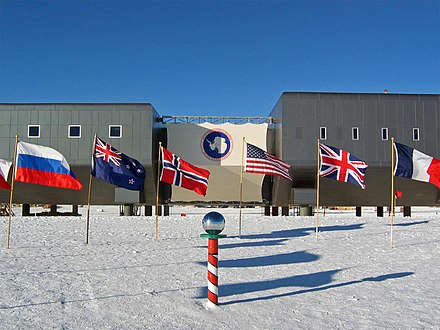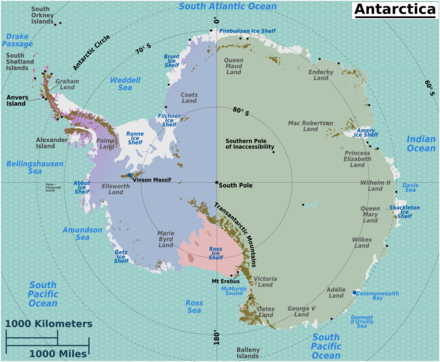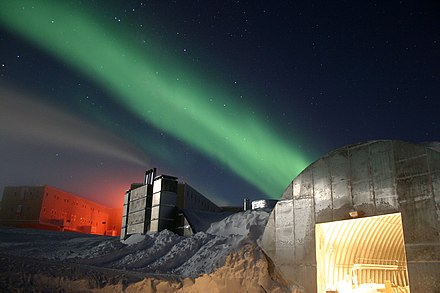South Pole
South Pole
The Geographic South Pole is the point where the Earth's axis of rotation intersects the surface of the southern hemisphere, in the remote, bleak interior of Antarctica. The underlying land is close to sea-level but is covered by ice over 2.5 km thick, so the surface is at 2835 m / 9301 ft on a flat, featureless plateau. The Pole was first reached by Amundsen in 1911, and the permanent US Amundsen-Scott South Pole Station has stood here since 1956.
Unless otherwise specified, references on these pages to "the Pole" mean this place. It shifts a few metres each year as the ice cap slowly moves, and there's also a "polar motion" as the earth's spin is slightly lopsided so the axis of rotation oscillates. See East Antarctica for the South Geomagnetic Pole and "Pole of Inaccessibility", both some 800-900 km away across the plateau, and for the South Magnetic Pole, which is way out to sea beyond Wilkes Land.
Understand
 19th century explorers probed Antarctica's coasts but realized that the Pole lay over 1000 km inland in an intensely cold, uncharted region. The best route was from the Ross Sea, which ships could approach in summer. There you'd need to establish a base and lay supply caches along your return route, and camp over winter, to be ready to strike out for the Pole next spring and get back before the following winter overtook you. And how would you even know (and prove to the world) that you'd got there?
19th century explorers probed Antarctica's coasts but realized that the Pole lay over 1000 km inland in an intensely cold, uncharted region. The best route was from the Ross Sea, which ships could approach in summer. There you'd need to establish a base and lay supply caches along your return route, and camp over winter, to be ready to strike out for the Pole next spring and get back before the following winter overtook you. And how would you even know (and prove to the world) that you'd got there?
Several expeditions were forced back, the closest being Shackleton's Nimrod group of 1908 / 09 which got to within 180 km. This established that the interior beyond the Transantarctic Mountains was a featureless high-altitude plateau. Roald Amundsen (1872-1928) initially aimed for the North Pole, but this target was mired by contested claims of Peary and others to have reached it, and funding dried up. (Not until 1926 did Amundsen himself bring the first verified party to the North Pole, by airship.) He secretly switched focus to the South Pole and didn't even tell his crew until they'd left their last port-of-call in Madeira. They reached Antarctica in Jan 1911, camping on the edge of the Ross Sea ice shelf. They laid caches then in October set out with dog-hauled sleds along a straight line south, crossing the mountains by the Axel Heiberg Glacier, and reached the Pole on 14 Dec. They returned safely to the coast in Jan 1912. Just as they were doing so, Scott's Terra Nova expedition belatedly reached the Pole, to find Amundsen's tents and the Norwegian flag fluttering there. That group of five did not survive their return north.
No-one stepped foot on the Pole again until 1956, when a US Navy plane landed. Over the summer of 1956/57, the "International Geophysical Year", the US built a station that's been permanently staffed since. The next people to come overland, with limited air support, were Edmund Hillary and Vivian Fuchs, arriving separately in Jan 1958. The age of tourism began in 1987 with the opening of privately-run Patriot Hills airfield and camp, which in 2010/11 relocated to Union Glacier Camp, and this remains in use.
The climate at the South Pole is intensely cold, though it's not the coldest place on earth - that's in the vicinity of Vostok station at higher altitude. In December, mid-summer, the Pole averages , and in July this drops to . (There are no "day-time highs" or "night-time lows", since in summer it's always day and in winter it's always night.) The Pole is also very dry, and indeed is classed as desert. It seldom catches the furious "katabatic" winds that scourge the coast. However, it doesn't take much breeze to kick up the drifting snow into a blizzard white-out that will disorient then bury anyone caught out in it.
Get in

By plane
Jack F. Paulus Skiway 1 km from the Pole is the airstrip, open in summer Oct-Feb. Only ski-planes can land here, though this includes chunky ski-equipped Lockheed Hercules. Tourists make the first leg of their journey (say from Punta Arenas) by conventional wheeled aircraft to one of the few Antarctic airfields that can receive them, then transfer to ski-plane. There may be a stopover of a couple of days at the transfer point to await a weather window to fly onward. But on reaching the Pole the aircraft doesn't wait around: it keeps its engines turning to avoid freezing while it unloads then gets gone, so don't be forgetting your mittens under your seat.
There are no scheduled commercial flights to the Pole. Staff come and go on government-sponsored flights. Tourists arrive on fly-stay packages, for prices that start from US$65,000 pp.
- Antarctic Logistics and Expeditions (ALE) are the market leader, flying via their Union Glacier camp in West Antarctica. Their packages include:
- a day trip to the South Pole or overnight stay;
- "Ski the Last Degree" where you're dropped off at 89°S and spend two weeks ski-trekking the rest of the way;
- from coast to Pole, 1170 km with over two months skiing for eight hours a day, hauling a sled weighing 50-60 kg.
- Icetrek is ostensibly a different company yet offers packages, departure dates and prices identical to ALE.
- Northwest Passage offer similar packages, including a combi of "Last Degree" and climbing Mount Vinson.
- PolarQuest are mostly a cruise operation but they offer six to seven day trips by plane from Punta Arenas via Union Glacier to the Pole.
- White Desert flies you here business-class, for double the price of the other very expensive operators. Guests fly from Capetown in business jets to Whichaway Camp in Queen Maud Land (think deep-freeze glamping) then on to the Pole or along the coast to admire the Emperor penguins.
By road
 The South Pole Traverse or Highway is a 1600 km trail from McMurdo Station on the Ross Sea to the Pole. It's compacted snow with crevasses filled in and marked by flags. It can only be travelled by specialized tractors, hauling sleds with fuel and supplies. These aren't very nimble so the trail has to take a long swerve around the Transantarctic Mountains to come onto the plateau.
The South Pole Traverse or Highway is a 1600 km trail from McMurdo Station on the Ross Sea to the Pole. It's compacted snow with crevasses filled in and marked by flags. It can only be travelled by specialized tractors, hauling sleds with fuel and supplies. These aren't very nimble so the trail has to take a long swerve around the Transantarctic Mountains to come onto the plateau.
Ski treks from coast to Pole are partly along this route, but take short-cuts through the mountains to bring the distance below 1200 km.
Get around
The area of interest is all within one km of the Pole along marked trails, so you get around on foot. Never leave these trails. There's simply nowhere else to go - the next point of interest is Kunlun station over 1000 km away, and frankly not worth the walk. This is a featureless plateau where conditions can turn from sparkling daylight to howling blizzard in an instant. The wind whips up the snow into a white-out where you have no sense of where you're going, and your trail gets covered so you can't retrace your route.
See and do

See Antarctica for general suggestions. The most important thing to do here is come home safe.
- The ceremonial South Pole is a metal sphere on a red and white pole, set within the flags of the signatories of the Antarctic Treaty. It makes a good photo but is about 300 m from the true Pole. (Yes, to be specific it's 300 metres north.)
- The Geographic South Pole is marked by a simpler rod. The ice here shifts 10 m annually and the marker is moved each New Year's Day in a small ceremony. There are also the US and Norwegian flags and a sign bearing quotes from the journals of Amundsen and Scott. Circumnavigate the world by taking a couple of dozen steps around the Pole.
- There have been three generations of station structures:
- The Old Pole, the original wooden station, was built in 1956 and abandoned in 1975. It's now buried by drifting snow, and off-limits as unsafe.
- The Geodesic Dome of the 1970s was dismantled in 2009 / 10 and its site soon became covered by snow.
- The Elevated Station, built from 1999, is a modular structure on stilts to prevent snow from accumulating around it. Semicylindrical metal "arches" next to the dome serve as storage, power plant, and vehicle shop. They linked to the main station via a six-story unheated metal tower known as the "beer can".
- The Visitor Center is a grand name for a small tent.
- Station tours: you can but ask the staff, but the answer is usually "sorry".
- Play Disc Golf: this is the version where you flip a disc towards a target basket, playing your disc from wherever it lands. But it's odd that no golf course developer has sought to establish a traditional course and resort hotel here. Where's Donald Trump when you want him?
- Send a letter home from the world's southernmost post office in the station.
Buy
There is a small gift shop in the station, cash only.
Eat
 Visitors are fed at the camp site, and can't access the station canteen.
Visitors are fed at the camp site, and can't access the station canteen.
Drink
- There's no shortage of fresh ice, but unlocking the water requires fuel and a means of heating. That's not a problem at the polar station and camp, but on treks such as "Ski the Last Degree" these add weight, and lugging them raises a thirst.
- As in any very cold climate, never drink alcohol until you are safely in shelter. It's notorious for generating a false glow of warmth and well-being while your core body temperature ebbs away.
Sleep
Tourist visitors are accommodated at the campsite from the station and Pole, using "Arctic Oven" tents.
Stay healthy
 All the health and safety advice for Antarctica apply in force to the Pole. The main local factor is that intense dry cold is combined with altitude, so you need to acclimatize. That's usually done by spending a night at a staging post such as Union Glacier. The UV is also stronger at this altitude.
All the health and safety advice for Antarctica apply in force to the Pole. The main local factor is that intense dry cold is combined with altitude, so you need to acclimatize. That's usually done by spending a night at a staging post such as Union Glacier. The UV is also stronger at this altitude.
Connect
Connectivity at the Pole is extremely limited. For around four hours each day, NASA satellites are in view which provide reasonably high-bandwidth connections; these are used for uploading scientific data and for staff to browse the Internet or have audio and video calls with family and friends. Another eight to nine hours of connection are available on two military satellites, at significantly lower speeds. The rest of the time, the only access is through the Iridium satellite network, which covers the entire globe and has excellent coverage at the poles, but only offers low-quality (and expensive) voice calls and dialup-speed Internet.
Go next
You're tied to your package itinerary, so you must return north with them. They may have the option of side-trips from their Antarctic staging post, e.g. from Union Glacier to Mount Vinson, or from McMurdo to climb the active volcano Erebus.